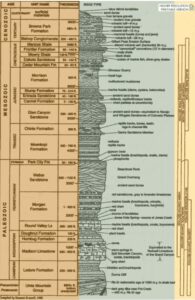Geology of the Yampa & Green River
Geology of the Yampa & Green Rivers
The Yampa River is a tributary of the Green River located in the western United States. The Yampa River is famous for being the last wild free flowing tributary of the Colorado River system. The geology of the Yampa and Green River basins is primarily composed of layered sedimentary rocks such as sandstone, limestone, and shale, which were deposited during the Paleozoic, Mesozoic and Cenozoic eras.
The Yampa River originates in the Park Range of the Rocky Mountains outside of Steamboat Springs, Colorado and flows on a westward course through the Yampa River Canyon, which is cut into the sandstone and shale of the Mesa Verde Group. The Yampa River then turns north and flows through Dinosaur National Monument, where it cuts an incredible canyon landscape composed of Weber Sandstone, Morgan Formation, Madison Limestone and several other geologic features.
The Green River, on the other hand, begins in the Wind River Mountains of Wyoming and flows south through the Green River Basin. Along its course, the Green River cuts through the rock layers of the Uinta Mountains. The most prominent formation the Green River cuts through is the Uinta Mountain group primarily the intense red rock that makes up the Uinta Mountain Group and the Lodore Formation. These two layers of rock are the predominant geologic timeline of the Gates of Lodore Canyon. The Green River then turns west and flows into the Uinta Basin, where it cuts through the rock layers of the Wasatch Formation and the Mancos Shale.
The Yampa and Green River join forces just east of the Utah and Colorado border in one of the most striking landscapes in the western United States, a place called Echo Park. Echo Park is at the heart of Dinosaur National Monument and a wonderful section of incredible scenery, natural and human history.

Both rivers are important for the ecosystem and human activities, The Yampa River is an important source of water for irrigation and recreation, and is home to a variety of fish and wildlife species. The Green River, on the other hand, is an important source of water for irrigation, hydroelectric power, and recreation, and is also home to a variety of fish and wildlife species.
Overall, the geology of the Yampa and Green River basins is characterized by layered sedimentary rocks that were deposited during the Paleozoic, Mesozoic and Cenozoic eras, and both rivers have shaped the landscape through erosion and deposition. The Yampa River flows through a narrow, steep-sided canyon, while the Green River flows through a variety of wide, flat valleys and deep rugged canyons. A Utah or Colorado white water river rafting adventure is a perfect way to see some of the most iconic geologic wonders of the Colorado River system.

